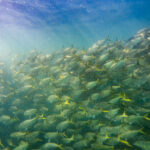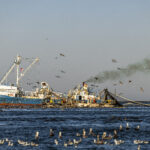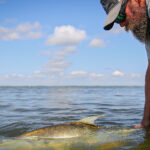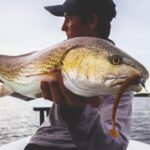
Take The Cut: Massive Reductions for Menhaden Industry Necessary
What’s going on? The “most important fish in the sea” just exposed one of the
ASGA and New England Aquarium announce the latest findings in The Albie Project that point towards one connected coast for false albacore.
First and foremost, ASGA would like to thank everyone who purchased Albie Project goods or donated directly to support our research efforts – and of course, our wonderful industry sponsors who commit their time, voice and resources to furthering our collective mission. None of this could happen without the tremendous support of the entire community. ASGA is a small association. Thank you for believing in us. The following blog provides the latest updates on the Albie Project. If audio format is your preferred way to digest information, we just published a new episode of the Guide Post Podcast with the New England Aquarium team today – you can access that here.
When we started The Albie Project, we had no idea what would happen with this project. Science could have told us things that we didn’t want to know. One fear was that a lot of albies would die through catch-and-release mortality – a justifiable concern with the bloody scenes albies can make in the boat. Another was that our albies would just swim out in the middle of the ocean and not get picked up by the receiver array located inshore. We heard the naysayers who doubted the validity of the research and we’re glad their attempts to devalue the campaign fell on deaf ears. Boy, is this blog heartwarming to write.

Science like this takes time. The data that we are about to share is an update. We aren’t done and by no means is this a conclusion. We are only sharing the data that we have accumulated to provide supporters and curious minds with a look into what we have learned so far.
As a reminder: telemetry tags were surgically inserted in the albies in Nantucket Sound. Our partners, New England Aquarium, own that receiver array and can download the information quickly. That way we know right away if the albie lived or died. Each tag emits a unique ping. When an albie swims by a receiver, the sound is picked up and recorded. You can learn more about the science by visiting the Mid-Atlantic Acoustic Telemetry Observation System. Here’s the catch: the albies are only recorded if they swim close to one of the receivers. How could we be so lucky?


We put telemetry tags in 63 albies. 57 pinged in Nantucket Sound and we thought that was awesome. To our surprise, two more were picked up off New York. That means we had 93.65% return rate. Albies are way tougher than we thought. Remember, we did surgery on these fish. Telemetry tags are way more invasive than a normal catch and release experience.
Once the water in Nantucket cooled, the albies headed down to Rhode Island, Long Island, and offshore of Southern New England. In all, 34 albies were detected outside of the original area. 21 out of the 34 appeared in waters off the coast of North Carolina between November 22 and April 23. That is a whopping 61.76% of the cohort that pinged outside of Massachusetts. Even more amazing, 5 of those were detected off the Florida Keys in March and April of 23. Three rockstar albies were detected in both locations. It only took 23 days for one of them to travel from North Carolina to the lower Keys. Talk about wanderlust.

We are not drawing any conclusions yet. We are focused on adding to this data set and have already begun deploying tags for our second season. But there are a few takeaways that we can share. This data along with our DNA research is showing us evidence that false albacore are a single, connected population. There is even more evidence coming in from the Eastern Atlantic that shows a different and distinct population that does not mix with our fish. This is preliminary but very encouraging for management purposes.
In addition to the telemetry research, ASGA guides deployed over 200 traditional spaghetti tags. All recaptures of those tagged fish to date are painting the same picture. In one case, two albies were tagged only minutes apart in October in Martha’s Vineyard by Gorilla Tactics Sportfishing. Those fish were recaptured off Jupiter and Boca Raton Florida a few days apart in July-August. In only ten months, there have been 6 recaptures reported. Some of our Florida guides deployed dozens of tags during their summer “bonita” bite (we’ll work on the common nomenclature over time…). We are anxious to see if any of those fish are recaptured this season during the New England fall craze.

We are ramping up both traditional and telemetry tagging efforts. There are plans to continue our DNA work as well. The biggest question we get is “How can we help?” We have made that very easy. ASGA has teamed up with Got One App to collect data on critical species. You may have caught the podcast two weeks ago regarding our partnership with Got One and the Massachusetts Division of Marine Fisheries to assist with the post-release mortality study on striped bass. We are now collecting the length of caught and released albies. This data will go a long way in increasing our understanding of stock dynamics for false albacore. There is going to be a big update to the GotOne app in the upcoming days. The camera feature will go online allowing you to record an image of the fish as well as backlog old photos to create a personal fishing log second to none. The technology this app provides will vastly increase your understanding of your target species while providing science with valuable information. We’re humbled by the excitement around our tagging efforts, but tagging kits and resources still remain limited. If you aren’t one of the current tagging captains and sincerely do want to help, please download the GotOne app and record your albie and striper catches. In addition to contributing to a higher understanding of our fisheries, you’ll gain some insane insight into your fishing performance based on tons of local variables. (Seriously, listen to the episode about the GotOne App – there’s a lot to learn AND most importantly, any shared scientific data is batched within a 15-mile radius. No spot burns.)
Once again, we sincerely thank you all for supporting The Albie Project. It is always fun for us to write an update that provides the community with exciting new information about their favorite fisheries and provides hope for the future. We are fishermen at our core and hope is deeply engrained in our DNA. ASGA will continue to drive Science, Education, and Advocacy so that the next generation has the same opportunities to fall in love with fishing as we have.

What’s going on? The “most important fish in the sea” just exposed one of the

Mario CampoFisheries Ecologist, Southeastern Louisiana UniversityScience and Policy Associate, American Saltwater Guides Association This discussion

The Jack Project continues to gather momentum as tagging teams across the Gulf and South

This guide is meant to educate anglers, conservationists, and the public about the Atlantic States
We rely on our members and donations to keep fighting for a sustainable tomorrow in marine conservation.
New science shows 275,000,000 lb discrepancy that requires immediate action!
GIVE THE GIFT OF FISHERIES CONSERVATION THIS HOLIDAY SEASON. SHOP ASGA GOODS THAT FUND FISHERIES RESEARCH & ADVOCACY CAMPAIGNS
JOIN ASGA IN CALLING FOR CRITICAL MANAGEMENT ACTION AFTER YEARS OF SPAWN FAILURES & POOR MANAGEMENT.
By using this website, you agree to our use of cookies. We use cookies to provide you with a great experience and to help our website run effectively. To learn more, please review our privacy policy.
One Response